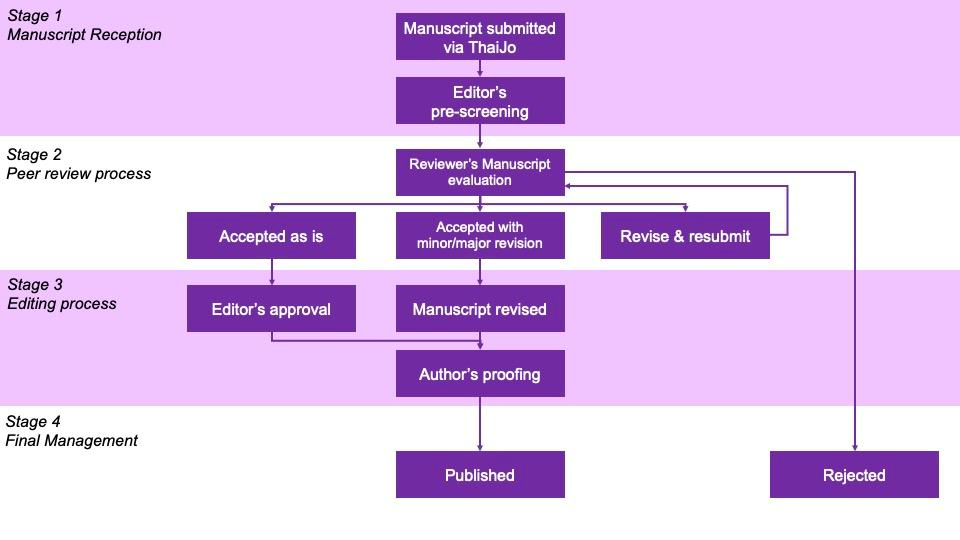Author Guidelines
The followings are guidelines for those wishing to submit an article for publication in rEFLections.
| SUBMISSION CATEGORIES |
|
rEFLections welcomes submissions in three categories: 1. Research articles - Manuscript should be approximately 7,000 – 10,000 words, excluding references |
| MANUSCRIPT PREPARATION |
|
1. Language of publication: English 2. Manuscript style: APA Style 7th Edition 3. Manuscript length: - Research articles - 7,000 – 10,000 words (excluding references and appendix) 4. Manuscript format: Microsoft Word/single-spaced, Times New Roman/12 points, and 1-inch (2.54 cm) 5. Template of article: 5.1 Title – The title should be concise and clearly reflect the content of the article. 6. Submission requirements: 6.1 The manuscript must be an original work that has not been published elsewhere and that is not being |
| PROCEDURES & CRITERIA FOR CONSIDERING AN ARTICLE |
|
1. The editors conduct an initial evaluation of an article. Articles that do not fall within the scope of the journal 2. The articles that pass the screenings will be submitted to two reviewers using double-blind review process. 3. The reviewers review the articles considering the academic value, academic correctness, and quality of the 4. If the article has to be revised, the authors should follow suggestions. However, authors can justify their 5. The editors will review the revised article for reader-friendliness and appropriate citations. The authors will 6. Authors whose manuscripts have been accepted for publication will be asked to conduct the final proofings 7. If the author breaches the ethical standard of publication, such as plagiarism and double publication, the
Peer Review Process Notes: Copyright to the article is retained by the author(s) but rEFLections reserves the right for the article's first |
| SUBMISSION REQUIREMENTS |
|
The submission should include the following two documents. Note that the manuscript will not be processed 1. A cover page including: 1.1 Author(s)' information including the author(s)' name(s), affiliation, address, telephone number, and e- 2. An anonymised manuscript – Make sure that the manuscript do not have the author(s)' name(s) since |
| LANGUAGE REQUIREMENTS |
|
Manuscripts should ideally be proofread by the author(s) or a certified proofreader upon submission. If a 1. Privately sourced proofreading services – Author(s) are given the liberty to source their own 2. In-house proofreading services at rEFLections – Author(s) are given the option of sourcing our in- 2.1 Completion within 5 days: THB 10,000 |
| DEADLINES FOR SUBMISSION |
|
rEFLections publishes three issues a year: from January to April, May to August and September to December. |
| PREVIOUS ISSUES |
|
Previous issues are available online at https://www.tci-thaijo.org/index.php/reflections/issue/archive. |
2. Reference List
|
Journal articles |
|
|
Format |
Author, A. A., & Author, B. B. (Year). Title of the article: Subtitle. Title of the Journal, |
|
Example |
1 and 2 author More than 2 authors With DOI (include DOI in the reference after the publisher name) An article within a special issue (Use the format for a journal article.) |
|
Magazines and news articles |
|
|
Format |
Author, A. A. & Author, B. B. (Year, Month dd). Title of the article: Subtitle. Title of the |
|
Examples |
Lyons, D. (2009, June 15). Don’t ‘iTune’ us: It’s geeks versus writers. Guess who’s Without the name of the author(s) With DOI Without DOI, but having a URL |
|
Books and eBooks |
|
|
Format |
Author, A. A. & Author, B. B. (Year). Title of book: Subtitle. Publisher Name. |
|
Example |
Whole authored book With DOI New edition of a book (Put the new edition at the end of the book title.) Whole edited book (Use the editor’ name(s) instead of the author(s).) eBook with stable URL |
|
Chapters in edited books |
|
|
Format |
Author, A. A. & Author, B. B. (Year). Title of the article. In A. A. Author & B. B. Author |
|
Example |
Chapter in an edited book Chapter in an edited book with DOI Dictionary and encyclopedia |
|
Organization documents and reports |
|
|
Format |
Author, A. A., & Author, B. B. (Year) or (Year, Month day). Title of the report. Publisher |
|
Example |
British Council (n.d.). IELTS TASK 2 Writing band descriptors (public version). |
|
Conference papers and presentations |
|
|
Format |
Presenter, A. & Presenter, B. (Year, Month dd-dd). Title of conference paper or poster |
|
Example |
Conference articles in regularly published conference proceedings (Use the Conference proceedings published in a journal (Use the journal article format.) Conference proceedings published as a whole book (Use the book format.) Conference proceedings published as a book chapter (Use the edited book chapter Conference paper presentation Conference poster presentation |
|
Theses and dissertations |
|
|
Format |
Format for published theses and dissertations (available in a database, a university |
|
Examples |
Fitzpatrick, D. (2011). Making sense of the English language policy in Thailand: An |
|
Format |
Format for unpublished theses and dissertations (sourced directly from the |
|
Examples |
Puripunyavanich, M. (2017). Developing oral communication ability of economics |
|
Webpages |
|
|
Format |
Author, A. A., & Author, B. B. (Year). Or (Year, Month). OR (Year, Month date). Title of the |
|
Examples |
Webpage on a website with an individual author Webpage on a website with a group author Include a retrieval date when the content is designed to change over time and |


